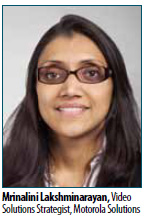The advantages of HD over SD are evident, but even after two years of “evangelization,” issues that hinder the overall performance of HD surveillance systems still linger. Transmission and storage are complex but easily resolved when enough money is thrown at the problem. Things are a bit different on the management and display side, where manufacturers still have a bit of work to do to optimize the software and hardware for better visibility and increased interoperability.
The advantages of HD over SD are evident, but even after two years of “evangelization,” issues that hinder the overall performance of HD surveillance systems still linger. Transmission and storage are complex but easily resolved when enough money is thrown at the problem. Things are a bit different on the management and display side, where manufacturers still have a bit of work to do to optimize the software and hardware for better visibility and increased interoperability. 
Newer IP-based video systems, regardless of image resolution, have many useful functionalities, but also require significant technical and business operation knowledge to ensure they can achieve the user 's goals, warned Mrinalini Lakshminarayan, Video Solutions Strategist for Motorola Solutions. “Moreover, there are many different components in these systems (different cameras, VMS, diverse networks), which could lead to more complex compatibility issues. Even the claims of being standardscompliant may not be totally correct. Reading the fine print and looking at what the specs are not saying are critical in ensuring proper operation of the system.”
Users and integrators should be careful when designing systems with these products, Lakshminarayan continued. “Open and flexible designs are critical to futureproof systems. Vendor specification and marketing messages could be misleading. Design and implementations based primarily on vendor specification could pose challenges unless the whole system is architected to fit the environment and needs of the user.” 
Furthermore,the growing coexistence of analog and digital technologies presents consequences involving bandwidth, storage, retrieval and image management , said Mark Wilson, VP of Marketing for Infinova. “There are different uses and purposes of stored video, various locations where images can be stored, a myriad of storage types, and business and operations issues to consider.”
System Overload
Today's VMS and cameras can use H.264, handle multiple megapixel streams and run onboard analytics on video, and it is very common for vendors to market all of these features.
However, network cameras are, in essence, small devices that could be likened to computers. When you have too many applications consuming the available resources, the system becomes sluggish and unstable, eventually leading to system failure. Network cameras use computer-like chips or accelerators for video, and they tend to perform similarly, Lakshminarayan explained. “Specifically, you should be careful about megapixel streams and video analytics; both can take huge amounts of resources and can place significant constraints relative to the marketing claims presented.” 
Superior image quality is, in part, fulfilled through more advanced image sensors, higher frame rates and better low light performance; more processing power is needed to implement and utilize these improvements, as they add load to hardware components such as the image pipe, scaler, encoding and network communication, said Johan Paulsson, CTO of Axis Communications.
The Weight of Analytics
Running video analytics inside of the DVR offers a lot of potential, albeit at a cost. Analytics add cost whether onboard the camera or independently on the system, Lakshminarayan cautioned. In addition to considering channel counts and the types of video analytics, what is more important is to consider the user's goals to avoid wasting resources, both monetary and system-wise.
Video analytics require processing power and possibly dual-stream video, and these limit the number of network cameras you may be able to support, Lakshminarayan said. “The more activity there is on your cameras, the less you may be able to manage. Network cameras can send multiple streams, use multiple codecs and run a variety of video analytics. Analytics still require additional server-side processing. The design and implementation have to take these into considerations.”
This can be quite difficult because it depends on the tools provided in the products used, Lakshminarayan continued. “In cameras and hybrid DVRs, you are dependent on what the manufacturer gives you. In most of these products, there are few to no tools. With IP video surveillance software, even if the software does not provide you with good tools, you can still use standard monitoring applications provided with the OS.”